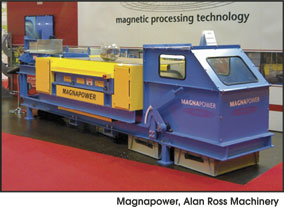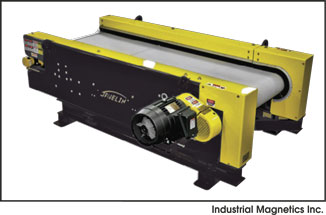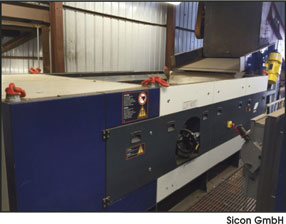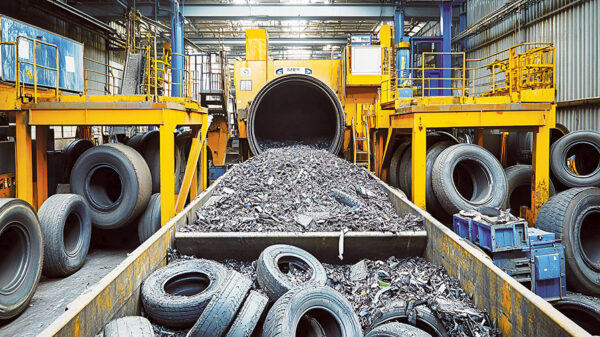by MARY M. COX
Manufacturer List
|
As long as metal is recycled, it will also be important to achieve efficient and comprehensive recovery of the material in the process.
Eddy current sorting is used when a processor wants to recover valuable nonferrous metals (e.g., aluminum), or when reactive nonferrous metals are a contaminant that must be removed from other materials (e.g., aluminum from plastics). Typical applications include automobile shredder residue (ASR), aluminum reprocessing, electronic scrap recycling, dross separation and MRF applications.

Magnapower, in Birmingham, England, designs and manufactures three eddy current separator (ECS) models. A light-duty concentric unit for MRF/can applications; an eccentric heavy duty unit for scrap processors, eScrap and mining; and an eccentric super-fines unit for material under 4mm. All three models are available in sizes from 24” to 80”. Magnapower heavy duty and super-fines model ECS units provide processors with high inductive force and high frequency performance characteristics in a standard ECS rotor. Typically, the higher the frequency of an ECS rotor, the lower the inductive force, but the Magnapower staff seeks to provide product users with both attributes. The most common configuration includes a vibratory feeder used to present a monolayer of material to the ECS, and a rare-earth magnetic drum to remove ferrous fines prior to ECS sortation.
“As the price of sensor-sorting technologies declines, there will likely be an increased adoption of that technology by smaller to medium sized processors,” commented Rustin Ross, chief executive officer of the U.S. representative firm for Magnapower. “Until then, eddy current sortation remains the most accessible path to increasing scrap margins,” Ross stated. He said that Magnapower equipment is in use at three of the four largest global recyclers of metals. The firm’s two labs, one in Illinois and the other in the UK, provide testing environments for client materials. The staff at the UK headquarters works to constantly innovate and develop new products for material sorting. The company also manufactures drum magnets, crossbelt magnets, can sorters, frag drums and other separation and sortation machinery and equipment, including bespoke magnetic solutions for unusual or very challenging sortation applications. Most recently, Magnapower developed a custom magnetic system for delivering a very high purity aluminum frag from difficult to sort mixed aluminum inputs.
According to Dennis O’Leary, chief business development officer at Industrial Magnetics, “Our ECS has seen great strides in terms of magnetic geometry, magnet strength, rotational speeds, unit widths and belt speeds. All these developments were employed to attack certain needs presented by an ever-changing and growing waste stream in all sectors. The initial Javelin line started with an over 2” particle size removal and an under 1.5” particle size recovery unit. We then moved on to a stronger higher polarity unit for material that can be used across the board from +5” to < 3/8” particle sizes.”
O’Leary also noted, “One of the major attack points in ECS development is the ‘fines recovery unit.’ In talking to some processors, concerns have been voiced relative to the repeatability of ultra-fine particle recovery.
Our company will research, develop and incorporate technology in our systems that will give our customer the most marketable end-product. We want to be a problem-solver, not just a manufacturer of magnetic-based technology.
“In purchasing an eddy current or magnet, one of the single most important considerations is the customer’s comfort level with the manufacturer. Is the manufacturer suggesting the equipment that will solve our problem or selling what they have available to sell? Are they going to be around when they’re needed? Will they take care of problems if they arise? Do they keep spare parts on the shelf and are they reasonably priced? You can buy a great piece of equipment and rue the day you bought it if you can’t get help when you need it.”

Sicon America has supplied advanced solutions for the separation and refining of metals from ASR for 15 years. Besides single machines, Sicon designs complete customer-tailored processing plants, which separate all metals from ASR in the highest possible grade, ready for selling directly to smelters and refineries. “An ECS is especially helpful for gleaning small particles (ASR ultra-fines) and our Eddy Pro INPxs makes an extremely high recovery rate feasible. Also, Sicon’s LaserSort Zorba product can split metal into 15 different grades in one pass. Direct supply to smelters of any metal grade becomes a reality,” claimed Heiner Guschall, managing director.
The firm’s EddyPro INP series eddy, with larger rotor and higher magnetic force, rotates at a much lower RPM than other products on the market and still generates a greater force in the process. Guschall said, “Coupled with a double splitter, we find that our customers recover a foundry grade Twitch product on the long throw and a copper rich Zorba on the short throw. With this design, the EddyPro will capture Zorba down to 1/64” in size, allowing a much higher recovery. With the lower rotation, there is less heat generated on the bearings, which results in much lower maintenance needed.
The belt misalignment detector is a built in feature that decreases cost and maintenance. It keep helps prevent ripping belts and the “belt runs empty” mode, which keeps any ferritic material from being stationary over the rotor. The “belt runs empty” mode allows the belt to make a full rotation after power loss or shutoff to ensure the belt is empty before it stops.
“Today, many old or poorly designed eddy currents are in operation, which leads to a higher load of nonferrous metals in sensor sorters. Our EddyPro product increases the recovery of Zorba significantly and makes nonferrous downstream more profitable. So, our machines are also helpful relative to the Green Fence Policy from China. The policy is a good incentive for metal recyclers to maximize metal recovery and improve the quality of the separated products,” Guschall stated.
Published in the April 2018 Edition








